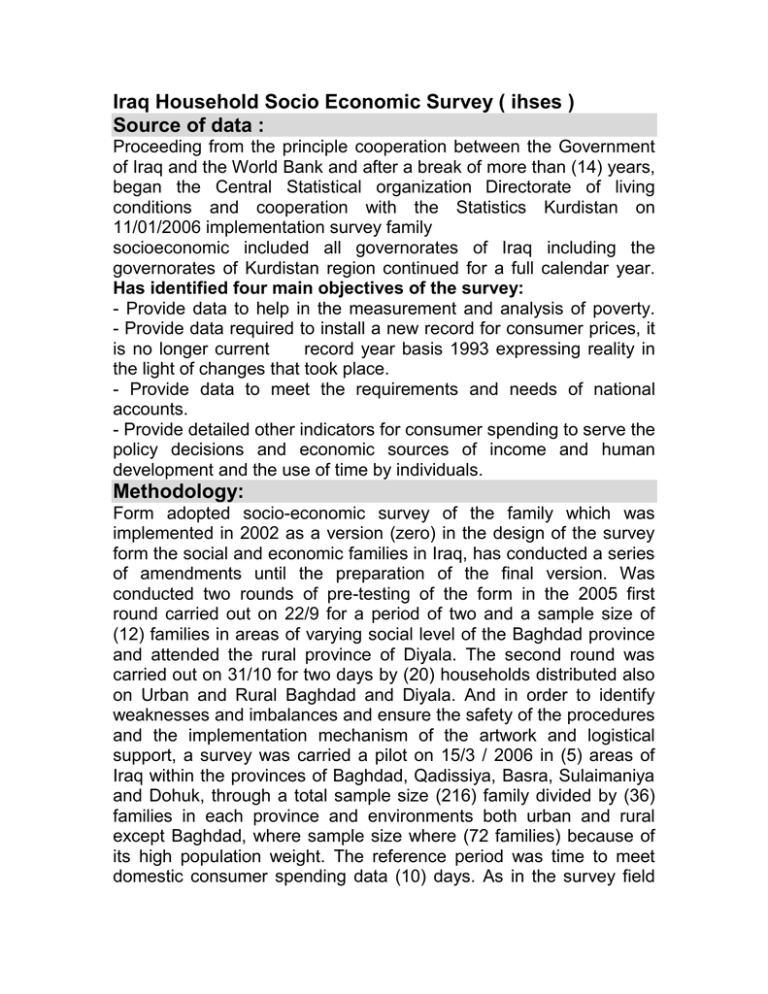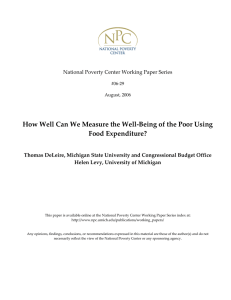Iraq Household Socio
advertisement

Iraq Household Socio Economic Survey ( ihses ) Source of data : Proceeding from the principle cooperation between the Government of Iraq and the World Bank and after a break of more than (14) years, began the Central Statistical organization Directorate of living conditions and cooperation with the Statistics Kurdistan on 11/01/2006 implementation survey family socioeconomic included all governorates of Iraq including the governorates of Kurdistan region continued for a full calendar year. Has identified four main objectives of the survey: - Provide data to help in the measurement and analysis of poverty. - Provide data required to install a new record for consumer prices, it is no longer current record year basis 1993 expressing reality in the light of changes that took place. - Provide data to meet the requirements and needs of national accounts. - Provide detailed other indicators for consumer spending to serve the policy decisions and economic sources of income and human development and the use of time by individuals. Methodology: Form adopted socio-economic survey of the family which was implemented in 2002 as a version (zero) in the design of the survey form the social and economic families in Iraq, has conducted a series of amendments until the preparation of the final version. Was conducted two rounds of pre-testing of the form in the 2005 first round carried out on 22/9 for a period of two and a sample size of (12) families in areas of varying social level of the Baghdad province and attended the rural province of Diyala. The second round was carried out on 31/10 for two days by (20) households distributed also on Urban and Rural Baghdad and Diyala. And in order to identify weaknesses and imbalances and ensure the safety of the procedures and the implementation mechanism of the artwork and logistical support, a survey was carried a pilot on 15/3 / 2006 in (5) areas of Iraq within the provinces of Baghdad, Qadissiya, Basra, Sulaimaniya and Dohuk, through a total sample size (216) family divided by (36) families in each province and environments both urban and rural except Baghdad, where sample size where (72 families) because of its high population weight. The reference period was time to meet domestic consumer spending data (10) days. As in the survey field work has continued (18) days during which implemented a plan for the completion of the data sections of the form and complete and migrate data record daily household expenditure. Survey questionnaire consisted of five parts (socio-economic data, monthly and quarterly expenditure and annual expenses, income and other, DRB book to spend, using time history). Sample Survey: The sample size (18 144) family, has been selected (324) families in each layer and the number of layers total (56) layer by one layer to attended the county and one layer for the rest of the urban and one layer for the rural area, which means that each province included three layers ... Except Baghdad included (5) layers so as to ensure the provision of level indicators of the environment (the county seat, the rest of the urban, rural) and at the provincial level, were selected (972) family of each province for the purpose of conducting field interviews with the exception of Baghdad, where selected (1620) family there. adopted under General Census of Population of 1997 for the provinces fifteen that participated in the census, ie all of Iraq's provinces except Kurdistan region where they were relying on this statistical frameworks prepared previously for not implementing the census where since 1987, in the province of Sulaymaniyah adopted framework population who prepared For the purposes of the draft compulsory education, while in Erbil and Dohuk has adopted under limited and punctuation to clear the living conditions which was implemented in 2004 after the update. was selected sample in two phases ie collects areas and the formation of units primary sampling and sample selection, including a first stage and then selecting households covered by a second stage. In the first phase were selected (54) and unit preview initial within each layer and randomly in a systematic manner with probability equal to size is then numbers lists and maps in each of the sampling units initial selected's 3024 unit for the purpose of addressing changes that have occurred since 1997 and until 2006. In the second stage of the sample selection, chosen (6) the families of each unit preview selected initial linear irregular manner. Thus, the total sample size consisting of 6 families of each of the primary sampling units amounting to 3024 units. It should be noted that the survey adopted the same sample MICS (2006) and Family Health Survey (2006), the same households were visited visited during the two surveys. Response rate of households that completed her interview 98.6%. the implementation of the survey: 12 Months field work, 8 months to prepare the final report. Concepts and terms: Family: normal family is defined as an individual or group of individuals bound together or unrelated, and living in a housing unit and one partial and share food and other necessities of life. Family size: The number of individuals living in the family usual the implementation time of the survey Age in completed years: Age was calculated according to date of birth Educational Status: means the educational status of the individual who at the age of (6) years and older at the time of the interview. Enrollment: is enrolled in each individual at the age of (6) years or more was recorded in the private educational institution or government, whether inside or outside Iraq, for at least one academic year and attend or are expected to attend for half the period recorded by or for a longer period. Educational level: These are years of study to get a certain level of education as if they are primary and six-year term or medium term of nine years, etc.. Qualification: is the highest qualification obtained for the individual and for the individual who did not get a qualification intended condition in terms of literacy or not and classified Qualification in degrees is Illiteracy, reads and writes, elementary, middle, preparatory, Diploma, B.Sc. , Higher Diploma, master, Doctorate. could not read and write simple statement in any language. Chronic diseases: is defined as long-term diseases such as heart problems and high blood pressure and diabetes for less injury period of 6 months ... Etc.. Disability (handicap): is the weakness or lack of physical or mental, such as cutting of hands or legs and paraplegia or physical disability or mental disability. Government health center are centers or institutions of the Ministry of Health, which provides health care services to the citizens. Fertility: is the sum of live births that occurred to women throughout her reproductive life (15-49). Live births: births that occur after the completion of the twenty-eighth week (7 months) and the fetus from the uterus with the emergence of signs of life as breathing and crying even if the fetus died immediately afterwards. Breastfeeding: intended to breast-feeding during the first six months of his birth Relationship to the labor force: means the case of an individual who at the age of 12 years and more as it relates to the labor market, during the past seven days ending on the day preceding the day of the interview. Full employment: each worker works for more than 34 hours a week and has no desire to Change the current work Or search for additional work. Underemployment phenomenon: everyone who works less than 35 hours per week and wants to increase the extra hours for the same work being late to work additional work alongside his current or that Change his job. Underemployment is the phenomenon: everyone who works more than 34 hours per week and wants to increase the extra hours in the same current work or to work extra work alongside his current or that Change his job because of inadequate salary or the small number of working hours available or because his current Does not fit qualifications scientific or because it's seasonal work, temporary or casual. Status: The Case Group in its work as it relates to the work and the operating point. Main work: is the work where worker More than spending half his time. Unemployment( standard definition ): all individuals within the working age who do not work even for one hour during the week backing, not even as an unpaid the family, and they were available for work or establish a special interest during the week backing and looked for work or tried to establish a special interestin earnest during the four weeks preceding the survey. excludes all those who were absent from work during the reference week.Full-time: longer work full-time if the working hours of not less than six hours a day.Parttime: longer work part-time if the number of hours of work not less than two and a half hours and less than six hours a day. Unemployment( definition lax ): all individuals within the working age who do not work even for one hour during the week backing, not even as an unpaid the family, and they were available for work or establish a special interest in a week attribution. Excludes that both had been absent from work during the reference week. Reason to stay out of the labor force: is the reason determined by the respondent for not doing the work or desire to work or search for it. This may be due to full-time study, or a full-time home business, or old age or disability or Deficit Below we desire to work to earn from outside work or for any other reasons. The dependency ratio: For the purposes of this survey, the dependency ratio is defined to reflect the number of individuals who are dependents per person of the workforce, and is calculated by dividing the total population with the exception of the labor force) workers and the unemployed (the number of the workforce. Current main economic activity: intended characterization of what is produced by the institution in which the individual works of economic goods or services provided, whether for the market or for barter or for private consumption. The workers who are not associated institutions are identifying and recording their economic activity based on the profession that they practice. Home Occupation: means the kind of work practiced by an individual worker during the week prior to the day of the interview. Actual working hours during the seven days preceding the day of the interview: This refers to the number of actual hours of work per capita during the time reference period, and include the normal working hours and overtime. Period of job search: It means the time period) in months and years (spent by the individual in the job search from the date of start looking for work until the date of the interview. The amount of monthly income: It is a total remuneration of or the person obtains from work during the previous month and may be as follows: 1. Income from Employment: Is the wage or salary received by the employee or worker) whether regular or temporary or trainees (in exchange for the work of others and this could be wage or salary in cash or in kind, including bonuses and overtime. 2. Login self employed: and intended to return cash or in kind received by the individual as a result of the exercise of his work for his own account, whether users to display or working alone and whether it's in the field of agriculture, industry or trade, services, or something like that. Net income: It means the total value of the income derived from any activity, after excluding costs (wages paid, the cost of intermediate consumption, benefits, direct taxes). Income from property: entry is that individuals get from property which is rents, profits and benefits and property rights. entry transformational: intended to enter manufacturing entry obtained by individuals free of charge for the purpose of social protection or may be compared to previous work such as payroll pensions for retired employees or retired workers ... Etc.. The recipient's income: income received by the family from all sources such as wages and salaries, income from economic activities, income from property, manufacturing access, and access other manufacturing assistance and subsidies. Income at market prices: the recipient's income is added to the difference between the market prices of the ration card and the prices paid to the agent. Agricultural holding: is an economic unit of agricultural production under a single administration and include all animals in all lands used wholly or partly for the purposes of agricultural production, regardless of ownership or legal form or geographical location or size may be administration per However one or more persons may consist possession of a piece and one or more in the area and one or more of the separate areas on the condition that all the pieces involved in the same production methods. Forests and forestry activities: This activity includes logging, firewood collection, reeds, collect truffles and mushrooms, sumac, nuts from wild trees, green bean, Heels ... Etc. Consumer spending family: intended to spend any of the family members on goods and services for the purposes of family consumer whether related to the family as a whole, such as food and housing, water and electricity consumption or related to members of the family, such as clothes, tools and individual purchases children. Prices paid: are prices paid by the family to buy goods and services, especially for the ration card items that were prices paid by the agent. Market prices: The average household expenditure after assessment of the ration card trade at market prices. Average per capita spending: is the total value of consumer spending for families divided by the number of individuals The main source of drinking water: is the source from which the family gets the largest amount of drinking water used compared with other sources. Among public network sources, the packages. . Etc. main source Electricity: is the source from which the family gets the largest amount of use of electricity for domestic use, compared with other sources. Among public network resources, etc.. The overall rate in the use of time: a contagious time user activity or effectiveness before each the surveyed Individuals who both practiced that activity or effective or not. The actual rate in the use of time: The average time used for an activity or event, on average for individuals surveyed, who have actually that activity or effectiveness. Poverty line: the total cost of goods and services required to meet basic consumption needs. The absolute poverty line: defined as the level of income and expenditure for the family or the individual to secure the needs of basic food related to housing, clothing, education, health and transport. Considered the absolute poverty line is more appropriate is characterized by a high degree of consistency in time and space, because it is based on the standard minimum required levels consumption necessary to satisfy the basic needs. The extreme poverty line: defined as the level of income and expenditure for the family or the individual to secure basic food needs, which provides him calories needed to exercise his normal daily activities. Relative poverty line: depends on that of earning less than a specified value in the income ladder is considered poor. Can vary across countries or over time, for example, sets the poverty line at half the average per capita income, and this implies that this line could increase with income. Poverty rate: an indicator which measures the relative importance of the poor in society and reflect the proportion of the poor to the total population, and regardless of the level of access to these poor people. And is measured at the individual level. Poverty size: is the proportion of individuals who fall below the poverty line, ie the proportion of individuals who can not secure their basic needs of food and non-food. Poverty gap: an indicator measures the total size of the gap between the incomes of the poor and the poverty line, and is calculated by monetary units it represents the total amount needed to raise the consumption levels of the poor to the poverty line. Statistical categories: First: the classification guide COICOP: -this classification is used in the indices prices Consumers and well as spending Form used in income and expenditure and consumption. And consumer divides household expenditure 1. Cash expenditure: intended to household purchases of goods and services, whether payment by cash or installments Or religion and record spending this full when item Or service become at the disposal of the family, whether it is consumed the time to get it or stock has remained for goods. 2. Spending is critical: It is intended for what you get family of goods from others without paying cash, but for work or as a gift or aid provided that the Nokia source Item family had obtained, leading to recognized in spending if they were covered by the survey) as if they are family that provided Item has bought Or obtained for work or gift Or assistance). This also includes spending on services obtained by the family of the other without the payment of cash provided that the party that provided the services it sells to others. 3. Self-consumption: is the value of what households consume produce farm animals or her garden or industry. Unlike cash for purchases and cash spending, spending to Not score this fully as they become good or service at the disposal of the family, but records what has actually consumed during the day. Second: International Standard Industrial Classification of economic activities - the third revision ISIC3: - rated industrial economic activities and familiar than 17 categories tabular (agriculture and forestry , fishing, mining and quarrying , manufacturing, Electricity, gas, steam and hot water supply, (construction) Erection structure, wholesale and retail trade and repair of motor vehicles, motorcycles and personal and household goods, hotels and restaurants, transport, storage and communications, financial intermediation, real estate activities and leasing and business services , public administration and defense , education, health and social work, activities community services and social services and other personal service personnel services for families, international organizations and embassies Third: International Standard Classification of Occupations issued by the International Labour Organization (ILO) in 1988 Relationship to the labor force: 1. Paid work: A person who works in any sector and is paid a lump, whether this remuneration in cash or in kind. 2. Employer: A person who owns and runs his own economic, or engages independently in a profession or trade, running people and one or more paid in cash or in kind. 3. Self-employed: A person who runs his own economic or engages independently in a profession or trade without using any person to assist him. 4. Working as unpaid family: A person who carries on business private, family-owned or one of its members without that is paid in kind or cash, and it has nothing to lump share in the profits. 5. Unemployed already work: A person who has previously correlation to the work in order to earn a living, but during the period of time reference has no connection with any action, although it is available to work, and the search for him during the time reference. 6. Loafers never work: A person who has never associated with any work inside or outside state, and available for work, as the search for him during the time reference. 7. A full-time student: A person enrolled in the study, which regularly with a view to obtaining the qualification. 8. Full-time domestic work: is the non-female, which Not looking for a job Do not attend scientific institutions, but devote themselves to the work of the house, with the exception of domestic workers do not include this concept, but classified as works. 9. His income or income: A person is able to work but for accuracy to Or Real Estate institution because of receiving a fixed income from property or real estate or other investments or retirement from the proceeds. 10. Unable to work (disability,illness): A person who is unable to work because of physical or mental disability or because of any other disease. 11. Old age: A person who is unable to work due to old age. 12. Does not want to work: A person is able to work but is not linked to his not want to work. Ways of calculating the indicators: 𝐀𝐯𝐞𝐫𝐚𝐠𝐞 𝐡𝐨𝐮𝐬𝐞𝐡𝐨𝐥𝐝 𝐬𝐢𝐳𝐞 = 𝐃𝐞𝐩𝐞𝐧𝐝𝐞𝐧𝐜𝐲 𝐫𝐚𝐭𝐞 = 𝐓𝐨𝐭𝐚𝐥 𝐢𝐧𝐝𝐢𝐯𝐢𝐝𝐮𝐚𝐥𝐬 𝐧𝐮𝐦𝐛𝐞𝐫 𝐨𝐟 𝐡𝐨𝐮𝐬𝐞𝐡𝐨𝐥𝐝𝐬 𝐧𝐮𝐦𝐛𝐞𝐫 𝐨𝐟 𝐢𝐧𝐝𝐢𝐯𝐢𝐝𝐮𝐚𝐥𝐬 𝐚𝐠𝐞 (𝟎 − 𝟏𝟒) + 𝐧𝐮𝐦𝐛𝐞𝐫 𝐨𝐟 𝐢𝐧𝐝𝐢𝐯𝐢𝐝𝐮𝐚𝐥𝐬 𝐚𝐠𝐞 𝟔𝟓 𝐲𝐞𝐚𝐫𝐬 𝐨𝐫 𝐦𝐨𝐫𝐞 𝐏𝐨𝐩𝐮𝐥𝐚𝐭𝐢𝐨𝐧 𝐚𝐠𝐞𝐝 (𝟏𝟓 − 𝟔𝟒)𝐲𝐞𝐚𝐫 𝐃𝐞𝐩𝐞𝐧𝐝𝐞𝐧𝐜𝐲 𝐫𝐚𝐭𝐞 𝐨𝐟 𝐜𝐡𝐢𝐥𝐝 = 𝐧𝐮𝐦𝐛𝐞𝐫 𝐨𝐟 𝐢𝐧𝐝𝐢𝐯𝐢𝐝𝐮𝐚𝐥𝐬 𝐚𝐠𝐞 (𝟎 − 𝟏𝟒) 𝐏𝐨𝐩𝐮𝐥𝐚𝐭𝐢𝐨𝐧 𝐚𝐠𝐞𝐝 (𝟏𝟓 − 𝟔𝟒)𝐲𝐞𝐚𝐫 Rate of female−headed household= 𝐎𝐯𝐞𝐫𝐜𝐫𝐨𝐰𝐝𝐢𝐧𝐠 = 𝐍𝐮𝐦𝐛𝐞𝐫 𝐨𝐟 𝐡𝐨𝐮𝐬𝐞𝐡𝐨𝐥𝐝𝐬 𝐡𝐞𝐚𝐝𝐞𝐝 𝐛𝐲 𝐰𝐨𝐦𝐚𝐧 × 𝐧𝐮𝐦𝐛𝐞𝐫𝐬 𝐨𝐟 𝐡𝐨𝐮𝐬𝐞𝐡𝐨𝐥𝐝 𝟏𝟎𝟎 𝐧𝐮𝐦𝐛𝐞𝐫 𝐨𝐟 𝐢𝐧𝐝𝐢𝐯𝐢𝐝𝐮𝐚𝐥𝐬 𝐭𝐡𝐚𝐭 𝐞𝐱𝐜𝐞𝐞𝐝 𝐭𝐡𝐞 𝐧𝐮𝐦𝐛𝐞𝐫 𝐨𝐟 𝐢𝐭𝐬 𝐦𝐞𝐦𝐛𝐞𝐫𝐬 𝟑 𝐚𝐧𝐝 𝐦𝐨𝐫𝐞 𝐰𝐢𝐭𝐡𝐢𝐧 𝐞𝐚 𝐧𝐮𝐦𝐛𝐞𝐫𝐬 𝐨𝐟 𝐡𝐨𝐮𝐬𝐞𝐡𝐨𝐥𝐝 Way of sanitation= 𝐓𝐡𝐞 𝐧𝐮𝐦𝐛𝐞𝐫 𝐨𝐟 𝐡𝐨𝐮𝐬𝐞𝐡𝐨𝐥𝐝𝐬 𝐭𝐡𝐚𝐭 𝐚𝐫𝐞 𝐜𝐨𝐧𝐧𝐞𝐜𝐭𝐞𝐝 𝐮𝐧𝐢𝐭 𝐫𝐞𝐬𝐢𝐝𝐞𝐧𝐭𝐢𝐚𝐥 𝐡𝐞𝐚𝐥𝐭𝐡 𝐦𝐞𝐚𝐧𝐬 𝐜𝐞𝐫𝐭𝐚𝐢𝐧 × 𝐧𝐮𝐦𝐛𝐞𝐫𝐬 𝐨𝐟 𝐡𝐨𝐮𝐬𝐞𝐡𝐨𝐥𝐝 𝐓𝐡𝐞 𝐚𝐯𝐞𝐫𝐚𝐠𝐞 𝐝𝐚𝐢𝐥𝐲 𝐧𝐮𝐦𝐛𝐞𝐫 𝐨𝐟 𝐡𝐨𝐮𝐫𝐬 𝐨𝐟 𝐩𝐫𝐨𝐜𝐞𝐬𝐬𝐢𝐧𝐠 𝐞𝐥𝐞𝐜𝐭𝐫𝐢𝐜𝐢𝐭𝐲 (𝐝𝐞𝐩𝐞𝐧𝐝𝐢𝐧𝐠 𝐨𝐧 𝐭𝐡𝐞 𝐬𝐨𝐮𝐫𝐜𝐞) = average of economic activity= Unemployment rate= 𝐓𝐡𝐞 𝐧𝐮𝐦𝐛𝐞𝐫 𝐨𝐟 𝐞𝐜𝐨𝐧𝐨𝐦𝐢𝐜𝐚𝐥𝐥𝐲 𝐚𝐜𝐭𝐢𝐯𝐞 𝐩𝐨𝐩𝐮𝐥𝐚𝐭𝐢𝐨𝐧 𝐚𝐠𝐞𝐝 𝟏𝟓 𝐲𝐞𝐚𝐫𝐬 𝐚𝐧𝐝 𝐨𝐯𝐞𝐫 × 𝐧𝐮𝐦𝐛𝐞𝐫𝐬 𝐨𝐟 𝐡𝐨𝐮𝐬𝐞𝐡𝐨𝐥𝐝 𝐍𝐮𝐦𝐛𝐞𝐫 𝐨𝐟 𝐮𝐧𝐞𝐦𝐩𝐥𝐨𝐲𝐞𝐝 𝐰𝐡𝐨 𝐚𝐫𝐞 𝐥𝐨𝐨𝐤𝐢𝐧𝐠 𝐟𝐨𝐫 𝐰𝐨𝐫𝐤 𝐚𝐭 𝐭𝐡𝐞 𝐚𝐠𝐞 𝐨𝐟 𝟏𝟓 𝐲𝐞𝐚𝐫𝐬 𝐚𝐧𝐝 𝐨𝐯𝐞𝐫 𝐓𝐡𝐞 𝐧𝐮𝐦𝐛𝐞𝐫 𝐨𝐟 𝐞𝐜𝐨𝐧𝐨𝐦𝐢𝐜𝐚𝐥𝐥𝐲 𝐚𝐜𝐭𝐢𝐯𝐞 𝐩𝐨𝐩𝐮𝐥𝐚𝐭𝐢𝐨𝐧 𝐚𝐠𝐞𝐝 𝟏𝟓 𝐲𝐞𝐚𝐫𝐬 𝐚𝐧𝐝 𝐨𝐯𝐞𝐫 𝟏𝟎𝟎 𝐍𝐮𝐦𝐛𝐞𝐫 𝐨𝐟 𝐡𝐨𝐮𝐫𝐬 𝐨𝐟 𝐩𝐫 𝐍𝐮𝐦𝐛𝐞𝐫 𝐨𝐟 𝐩𝐫𝐨𝐜𝐞𝐬𝐬𝐢 𝟏𝟎𝟎 × 𝟏𝟎𝟎 Economically active population=Working population+Unemployed population who are looking for work Working Population= Working population+ Unemployed population who are looking for work Working Population = (workers, a housewife working part-time, retired works, absent from work on a temporary basis) 𝐫𝐚𝐧𝐠𝐞 𝐢𝐧𝐝𝐢𝐯𝐢𝐝𝐮𝐚𝐥 𝐨𝐟 𝐞𝐱𝐩𝐞𝐧𝐝𝐢𝐭𝐮𝐫𝐞 = 𝐓𝐨𝐭𝐚𝐥 𝐚𝐦𝐨𝐮𝐧𝐭 𝐨𝐟 𝐜𝐨𝐧𝐬𝐮𝐦𝐞𝐫 𝐞𝐱𝐩𝐢𝐧𝐝𝐢𝐭𝐮𝐫𝐞 𝐧𝐮𝐦𝐛𝐞𝐫 𝐨𝐟 𝐢𝐧𝐝𝐢𝐯𝐢𝐝𝐮𝐚𝐥 𝐫𝐚𝐧𝐠𝐞 𝐨𝐟 𝐡𝐨𝐮𝐬𝐞𝐡𝐨𝐥𝐝 𝐞𝐱𝐩𝐞𝐧𝐝𝐢𝐭𝐮𝐫𝐞 = 𝐓𝐨𝐭𝐚𝐥 𝐚𝐦𝐨𝐮𝐧𝐭 𝐨𝐟 𝐜𝐨𝐧𝐬𝐮𝐦𝐞𝐫 𝐞𝐱𝐩𝐢𝐧𝐝𝐢𝐭𝐮𝐫𝐞 𝐧𝐮𝐦𝐛𝐞𝐫 𝐨𝐟 𝐡𝐨𝐮𝐬𝐞𝐡𝐨𝐥𝐝 Range individual income= 𝐓𝐡𝐞 𝐭𝐨𝐭𝐚𝐥 𝐢𝐧𝐜𝐨𝐦𝐞𝐬 𝐨𝐟 𝐚𝐥𝐥 𝐬𝐨𝐮𝐫𝐜𝐞𝐬 𝐨𝐟 𝐢𝐧𝐜𝐨𝐦𝐞 𝐧𝐮𝐦𝐛𝐞𝐫 𝐨𝐟 𝐢𝐧𝐝𝐢𝐯𝐢𝐝𝐮𝐚𝐥 Range household income= 𝐓𝐡𝐞 𝐭𝐨𝐭𝐚𝐥 𝐢𝐧𝐜𝐨𝐦𝐞𝐬 𝐨𝐟 𝐚𝐥𝐥 𝐬𝐨𝐮𝐫𝐜𝐞𝐬 𝐨𝐟 𝐢𝐧𝐜𝐨𝐦𝐞 𝐧𝐮𝐦𝐛𝐞𝐫 𝐨𝐟 𝐡𝐨𝐮𝐬𝐞𝐡𝐨𝐥𝐝𝐬 illiteracy rate= 𝐍𝐮𝐦𝐛𝐞𝐫 𝐨𝐟 𝐩𝐞𝐨𝐩𝐥𝐞 𝐰𝐡𝐨 𝐝𝐨 𝐧𝐨𝐭 𝐤𝐧𝐨𝐰 𝐡𝐨𝐰 𝐭𝐨 𝐫𝐞𝐚𝐝 𝐚𝐧𝐝 𝐰𝐫𝐢𝐭𝐞 𝟏𝟐 𝐲𝐞𝐚𝐫𝐬 𝐨𝐥𝐝 × 𝐏𝐨𝐩𝐮𝐥𝐚𝐭𝐢𝐨𝐧 𝐢𝐧 𝐭𝐡𝐞 𝐬𝐚𝐦𝐞 𝐚𝐠𝐞 𝐠𝐫𝐨𝐮𝐩 𝐧𝐞𝐭 𝐫𝐚𝐭𝐞 𝐨𝐟 𝐞𝐧𝐫𝐨𝐥𝐥𝐦𝐞𝐧𝐭 = 𝟏𝟎𝟎 𝐧𝐮𝐦𝐛𝐞𝐫 𝐨𝐟 𝐬𝐭𝐮𝐝𝐞𝐧𝐭𝐬 𝐰𝐡𝐨 𝐚𝐫𝐞(#) × 𝟏𝟎𝟎 𝐧𝐮𝐦𝐛𝐞𝐫 𝐨𝐟 𝐏𝐨𝐩𝐮𝐥𝐚𝐭𝐢𝐨𝐧(#) 𝐓𝐨𝐭𝐚𝐥 𝐞𝐧𝐫𝐨𝐥𝐥𝐦𝐞𝐧𝐭 𝐫𝐚𝐭𝐞 = 𝐧𝐮𝐦𝐛𝐞𝐫 𝐨𝐟 𝐬𝐭𝐮𝐝𝐞𝐧𝐭𝐬 𝐰𝐡𝐨 𝐚𝐫𝐞 × 𝟏𝟎𝟎 𝐧𝐮𝐦𝐛𝐞𝐫 𝐨𝐟 𝐏𝐨𝐩𝐮𝐥𝐚𝐭𝐢𝐨𝐧(#) # primary (6-11) INTERMEDIATE (12-14) PREPARATORY (15-17) University (17-23) Average number of years of study= 𝐍𝐮𝐦𝐛𝐞𝐫 𝐨𝐟 𝐬𝐜𝐡𝐨𝐨𝐥 𝐲𝐞𝐚𝐫𝐬 𝐬𝐩𝐞𝐧𝐭 𝐛𝐲 𝐚 𝐠𝐫𝐨𝐮𝐩 𝐨𝐟 𝐢𝐧𝐝𝐢𝐯𝐢𝐝𝐮𝐚𝐥𝐬 𝐢𝐧 𝐞𝐝𝐮𝐜𝐚𝐭𝐢𝐨𝐧 𝐓𝐡𝐞 𝐭𝐨𝐭𝐚𝐥 𝐧𝐮𝐦𝐛𝐞𝐫 𝐨𝐟 𝐦𝐞𝐦𝐛𝐞𝐫𝐬 𝐨𝐟 𝐭𝐡𝐞 𝐬𝐚𝐦𝐞 𝐠𝐫𝐨𝐮𝐩 Overall average used time= 𝐓𝐨𝐭𝐚𝐥 𝐭𝐢𝐦𝐞 𝐮𝐬𝐞𝐝 𝐢𝐧 𝐚 𝐩𝐚𝐫𝐭𝐢𝐜𝐮𝐥𝐚𝐫 𝐚𝐜𝐭𝐢𝐯𝐢𝐭𝐲 𝐓𝐡𝐞 𝐧𝐮𝐦𝐛𝐞𝐫 𝐨𝐟 𝐢𝐧𝐝𝐢𝐯𝐢𝐝𝐮𝐚𝐥𝐬 𝐜𝐨𝐯𝐞𝐫𝐞𝐝 𝐓𝐨𝐭𝐚𝐥 𝐭𝐢𝐦𝐞 𝐮𝐬𝐞𝐝 𝐢𝐧 𝐚 𝐩𝐚𝐫𝐭𝐢𝐜𝐮𝐥𝐚𝐫 𝐚𝐜𝐭𝐢𝐯𝐢𝐭𝐲 Actual average used time= 𝐍𝐮𝐦𝐛𝐞𝐫 𝐨𝐟 𝐢𝐧𝐝𝐢𝐯𝐢𝐝𝐮𝐚𝐥𝐬 𝐰𝐡𝐨 𝐚𝐜𝐭𝐮𝐚𝐥𝐥𝐲 𝐩𝐫𝐚𝐜𝐭𝐢𝐜𝐞𝐝 𝐚𝐜𝐭𝐢𝐯𝐢𝐭𝐲 The rate of poor individuals= 𝐍𝐮𝐦𝐛𝐞𝐫 𝐨𝐟 𝐢𝐧𝐝𝐢𝐯𝐢𝐝𝐮𝐚𝐥𝐬 𝐛𝐞𝐥𝐨𝐰 𝐭𝐡𝐞 𝐩𝐨𝐯𝐞𝐫𝐭𝐲 𝐥𝐢𝐧𝐞 × 𝐓𝐨𝐭𝐚𝐥 𝐩𝐨𝐩𝐮𝐥𝐚𝐭𝐢𝐨𝐧 𝟏𝟎𝟎 The rate of poor households= 𝐍𝐮𝐦𝐛𝐞𝐫 𝐨𝐟 𝐢𝐧𝐝𝐢𝐯𝐢𝐝𝐮𝐚𝐥𝐬 𝐛𝐞𝐥𝐨𝐰 𝐭𝐡𝐞 𝐩𝐨𝐯𝐞𝐫𝐭𝐲 𝐥𝐢𝐧𝐞 × 𝐓𝐨𝐭𝐚𝐥 𝐡𝐨𝐮𝐬𝐞𝐡𝐨𝐥𝐝 𝟏𝟎𝟎 Geographical breakdown: Geographical breakdown: indicators was dissemination according to governoratelevel Periodic survey: survey carried out on 1/11/2006- 1/11/2007 The data availability at fourm (excel , pdf) and can download to (CD )






